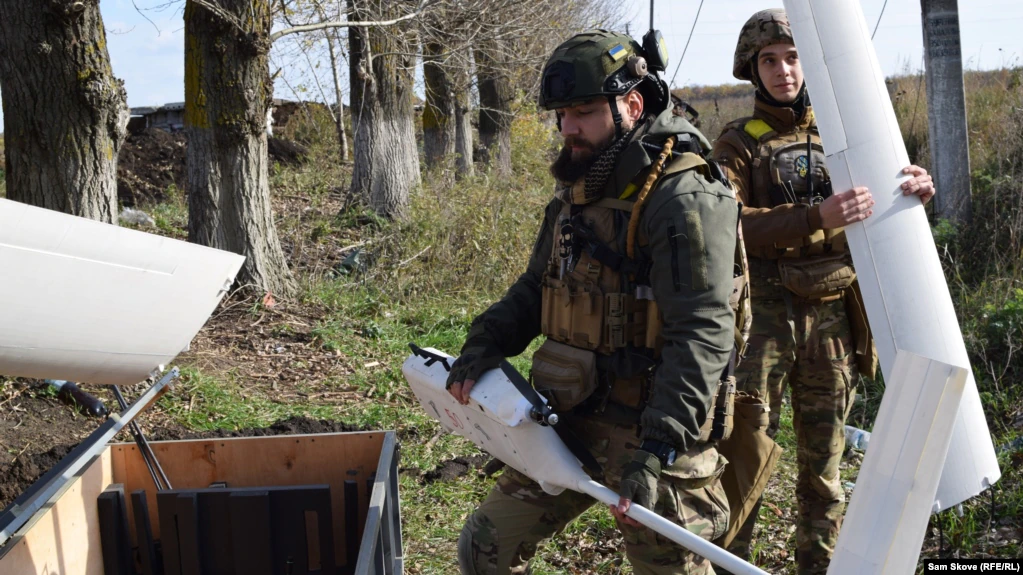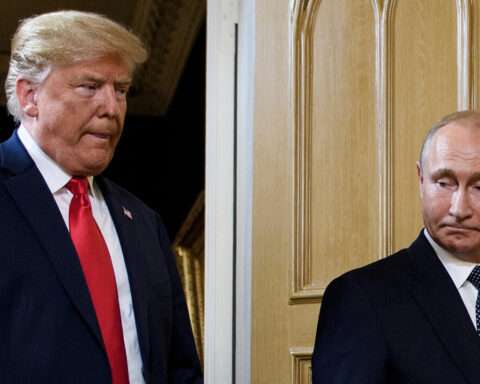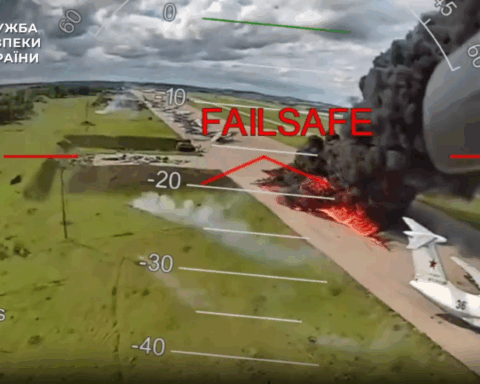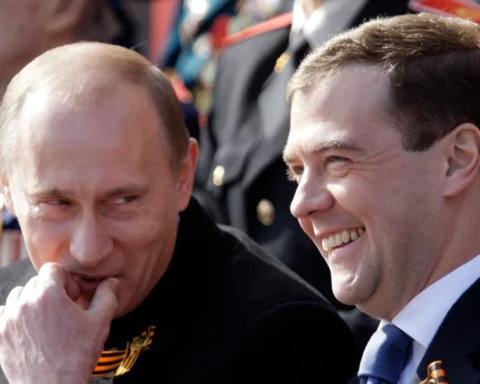KHARKIV REGION, Ukraine — Standing in a trench not far from the Russian border, a drone operator from the Ukrainian military unit Khartia didn’t look up at the sound of Russian shells slamming into the ground a few kilometers to his left.
Instead, his attention was fully focused on trying to get an experimental Ukrainian-made long-range drone off the ground. It was one of the few afternoons that week when the weather was good enough to fly.
None of the team of three drone operators that day was a computer whiz. “Guard,” who wore a big beard on his tattooed face, was a top-flight competitive bodybuilder before the war. “Lego” worked as a civil engineer. “Kim,” the wiry young man trying to troubleshoot the drone, worked in real estate. For security reasons, all three went only by their call signs.
As drone operators, their role as roving intelligence collectors puts them at the epicenter of resistance against the Russian invasion, now in its ninth month. Their journey from green recruits to veteran soldiers shows how much Ukraine has achieved, but their stories also show just how far Ukraine has to go in matters ranging from weapons to intelligence.

Drones play a vital role in the war in Ukraine, with both sides using them in large numbers to gather intelligence, correct artillery fire, and drop bombs.
Yaroslav Markevych, the terse drone unit commander for Khartia, described the combination of drones working with artillery as the “most important pair” in offensive operations and one of the keys to Ukraine’s stunning September counteroffensive in the Kharkiv region.
“It is precisely because there are drones that one can advance very quickly,” he said.
Ukraine is training hundreds of drone operators every month, and Ukrainian social media is awash with volunteers fund-raising to buy drones for military units.
With their body armor, medical kits, and hydration packs, and with Kalashnikov assault rifles in their hands, Guard, Lego, and Kim look like combat soldiers. Their work, though, includes far more staring at computer screens than their appearances might suggest.
“Civilian life helps — you’re used to sitting at a computer for a day,” said Lego. The name stems from his job as an engineer, where his work included projects at the Azovstal steel plant in Mariupol, now in ruins following a devastating Russian siege.
On a typical flight day, they’ll fly their camera-equipped drone over Russian positions, bring it back to their lines, and return to their base to upload their flight camera’s data into their computers.
The team then begins the painstaking process of identifying the location of Russian vehicles and bases. In order to find Russia’s often well-camouflaged equipment in their footage, they first use artificial intelligence to identify square objects. They then pore over the footage for hours, examining it closely for signs of targets.
Even small discrepancies may point to a Russian tank lurking under cover, such as whether the leaves in a certain area are dry while all the others are fresh.
After that, it’s up to their command and artillery units to identify which targets to hit. Once a target is selected, the operators will make a flight to confirm the target is still there. The double confirmation is necessary to avoid wasting precious artillery shells from Ukraine’s limited supply, the operators said.
Often standing just a few kilometers from their target, they’ll observe where Ukrainian artillery rounds land. Then, using Ukrainian military maps on their tablets, they’ll coordinate with the artillery to adjust fire using Starlink, a portable Internet terminal created by U.S. billionaire Elon Musk.

This cycle of field work and analysis can be exhausting. “For a week we’ll sleep just two hours,” Lego said. “We’ll fly till 7 p.m., then go to the base, and then analyze 3,500 photos from the flights.”
With the right equipment, they can be successful. Kim said Ukrainian artillery units using U.S.-supplied weapons like the M777 howitzer could land a direct hit with only three shots. The drone operators had high praise for Western weapons, especially the U.S. HIMARS rocket system and Excalibur GPS-guided artillery shells.
But frustration is frequent.
In the trench on a crisp late-October day in the Kharkiv region, where Russian forces still hold patches of territory in the east after the Ukraine regained large swaths of land in the counteroffensive, Kim hailed down a passing drone team from another unit an hour or so into his efforts to reboot the drone.
Using their laptop rather than his own, he attempted again to get the drone running. The drone remained on its crate, the ailerons on its long white wings uselessly flapping up and down.
WATCH: A Ukrainian mortar team takes pride in accurate strikes, even at a distance and at night, aided by drones that provide the exact location of Russian troops and military equipment.
The mere necessity of using an experimental drone on the battlefield is an indicator of the supply problems that Ukraine’s drone units face. Ukraine has added to its stock of military drones, but demand still far outpaces supply. Speaking to Ukrainian media in June, one Ukrainian drone company CEO said only about 20 percent of the Ukrainian military’s demand had been met.
For want of better supplies, the unit, like most drone units in Ukraine, relies heavily on commercial quadcopters better known in the United States for their applications in wedding photography, hobby videos, and the like.
With these drones, there are only minuses, Markevych said when interviewed earlier in the city of Kharkiv. An IT entrepreneur and ex-politician, he has been working with drones since 2014, when he fought against Russian-backed anti-Kyiv forces in the war that began that year in the Donbas, south and east of Kharkiv.
At the most basic level, the drones themselves are not made for the rigors of trench life – or warfare — and can be made inoperative by anything from bad weather to Russian shrapnel. And once a drone is launched, Russian electronic warfare units can also easily break the remote signal by which the operator controls it.
“We lose a lot of drones,” said Markevych.
Perhaps their biggest disadvantage is how close they require operators to move to the front line. The practical range of the commercial drones operated by Khartia is often around three kilometers, plus whatever zoom capacity they have. Russian artillery pieces far outrange this, with Russia’s self-propelled howitzer capable of firing almost 25 kilometers.
“As long as we’re using these household appliances, we’re forced to work on the zero line,” Markevych said, referring to the first and most dangerous line of Ukrainian positions.
Even if drone operators get their drones up without getting killed, all that work can go to waste if the artillery they’re working with isn’t up to the task.
Some of Ukraine’s many Soviet-era weapons can be horribly inaccurate. After peppering everywhere but the target with shells, Kim said, one artillery team they were working with simply gave up and chose another.

Technical issues aren’t the only problem.
Coordination between units can also falter at times. Due to rotations, a unit at the front line may have little idea of what lies ahead. To paper over these issues, the drone unit members introduce themselves at every new position.
“We come in and set up contacts with everyone,” Lego said. “We make friends.”
As if to prove the point, Lego exchanged phone numbers with one of the members of the drone team who’d stopped to help them with the loan of the laptop.
With the failure of the second team’s laptop, though, Lego, Kim, and Guard had had enough. Working together, they took the model’s wings off and placed it back in the enormous gray box before heaving it into the bed of their pickup truck.
Amid what he said was heavy Russian resistance around Svatove, in the Luhansk region, where Ukraine’s counteroffensive finally slowed, Lego reflected on the potential impact of Russia’s new military mobilization, which began late last month and could eventually send up to 300,000 conscripts to Ukraine.
“We’re fighting the war out of our pickup trucks,” he said, highlighting his team’s need for more armored vehicles to take the place of the civilian cars they often use. “It’s going to be really tough for us.”






